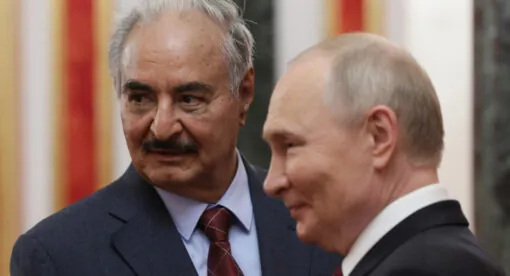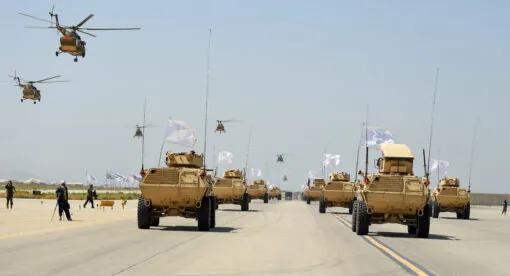The Weekly Forecast Monitor is a forward-looking assessment of geopolitical dynamics shaping our world. To get more in-depth analysis of these issues and learn more about analytical products from New Lines Institute — including simulations, training sessions, and forecast reports — contact us at [email protected] and visit https://newlinesinstitute.org/analytical-products/. Download PDF Version.
Global Hotspots
The Global Hotspot Tracker examines the outlook for key geopolitical hotspots around the world. (Go to the Global Connectivity Tracker)
Russia/Ukraine Conflict
Summary – The Russia-Ukraine conflict is trending toward military escalation and diplomatic de-escalation scenarios as Russia conducted its first joint bomber patrol with China near Alaska. Ukraine’s foreign minister visited China to discuss Beijing’s mediation efforts to end the war, while a new poll indicates an increase in the number of Ukrainians open to territorial concessions in exchange for peace.
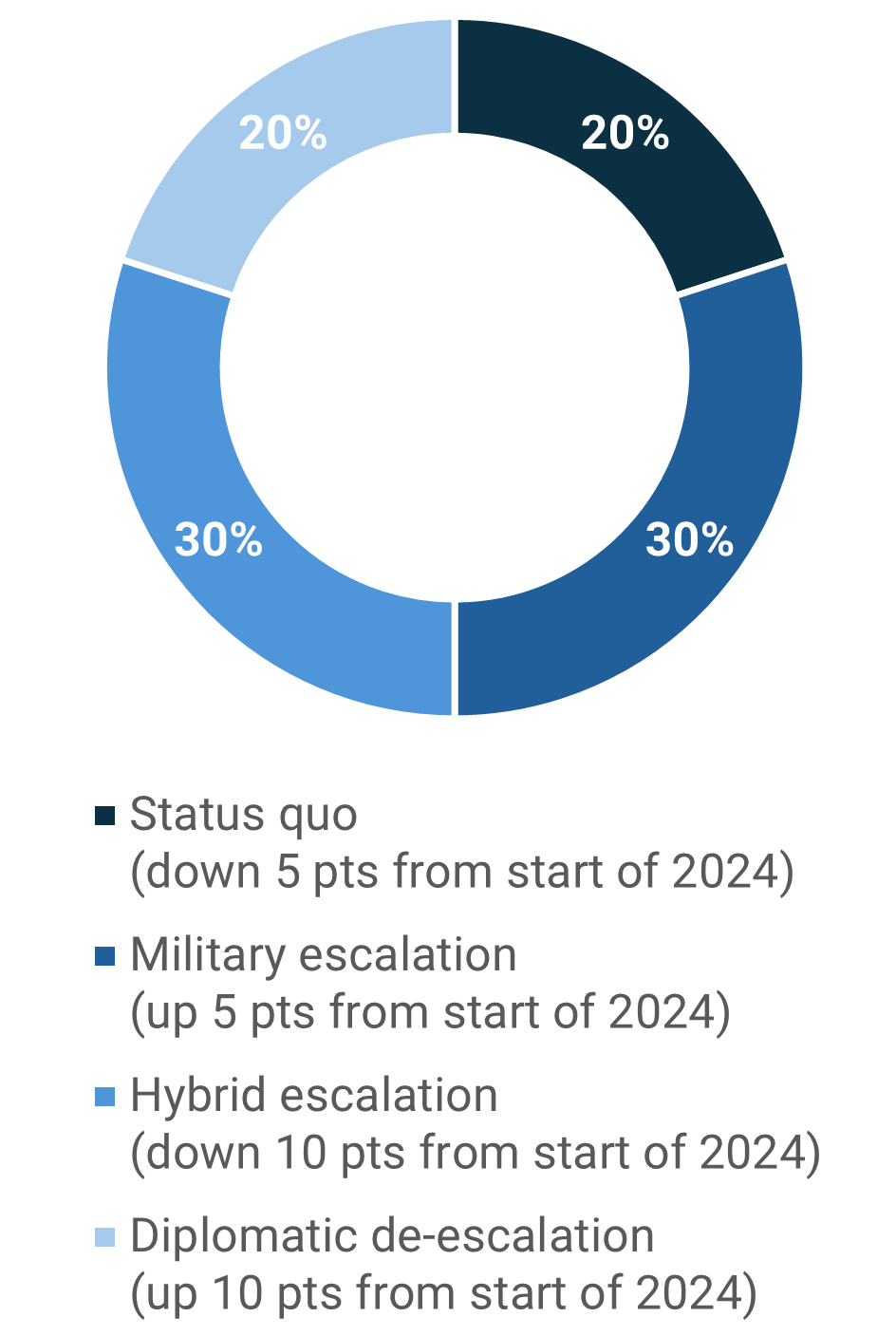
Military escalation scenario
- Russia and China flew a joint bomber patrol near Alaska for the first time, with two Russian TU-95 and two Chinese H-6 aircraft being tracked and intercepted by U.S. and Canadian fighter jets. The Russian and Chinese foreign ministers also vowed to jointly counter “extra-regional forces” in Southeast Asia.
Risk level – medium - Russia attacked Ukraine’s port city of Izmail with drones, with wreckage and debris from these drones landing near the Ukrainian border in a rural village in Romania.
Risk level – low/medium
Hybrid escalation scenario
- The EU announced its first transfer of $1.6 billion in profits from frozen Russian assets to Ukraine.
Risk level – medium - A Russian citizen was arrested in France and accused of planning acts of “destabilization” during the Paris Olympics.
Risk level – low/medium
Diplomatic de-escalation scenario
- The number of Ukrainians opposed to conceding territory to Russia in exchange for peace has fallen in recent months, reaching 55% in May compared to 74% in December 2023, according to a poll by the Kyiv International Institute for Sociology.
Opportunity level – low/medium - Ukrainian Foreign Minister Dmytro Kuleba visited China on the invitation of Beijing to meet with his Chinese counterpart for discussions on ending the war in Ukraine.
Opportunity level – low/medium
Middle East
Summary – Tensions in the Middle East trended toward military escalation and diplomatic de-escalation scenarios as Israel and Yemen’s al-Houthi rebels exchanged direct missile and drone attacks, prompting warnings of further retaliation. As Israel continued its offensive operations in southern Gaza, Israeli Prime Minister Benjamin Netanyahu addressed the U.S. Congress and met with key political leaders. China mediated a reconciliation agreement between Palestinian factions Hamas and Fatah in Beijing.
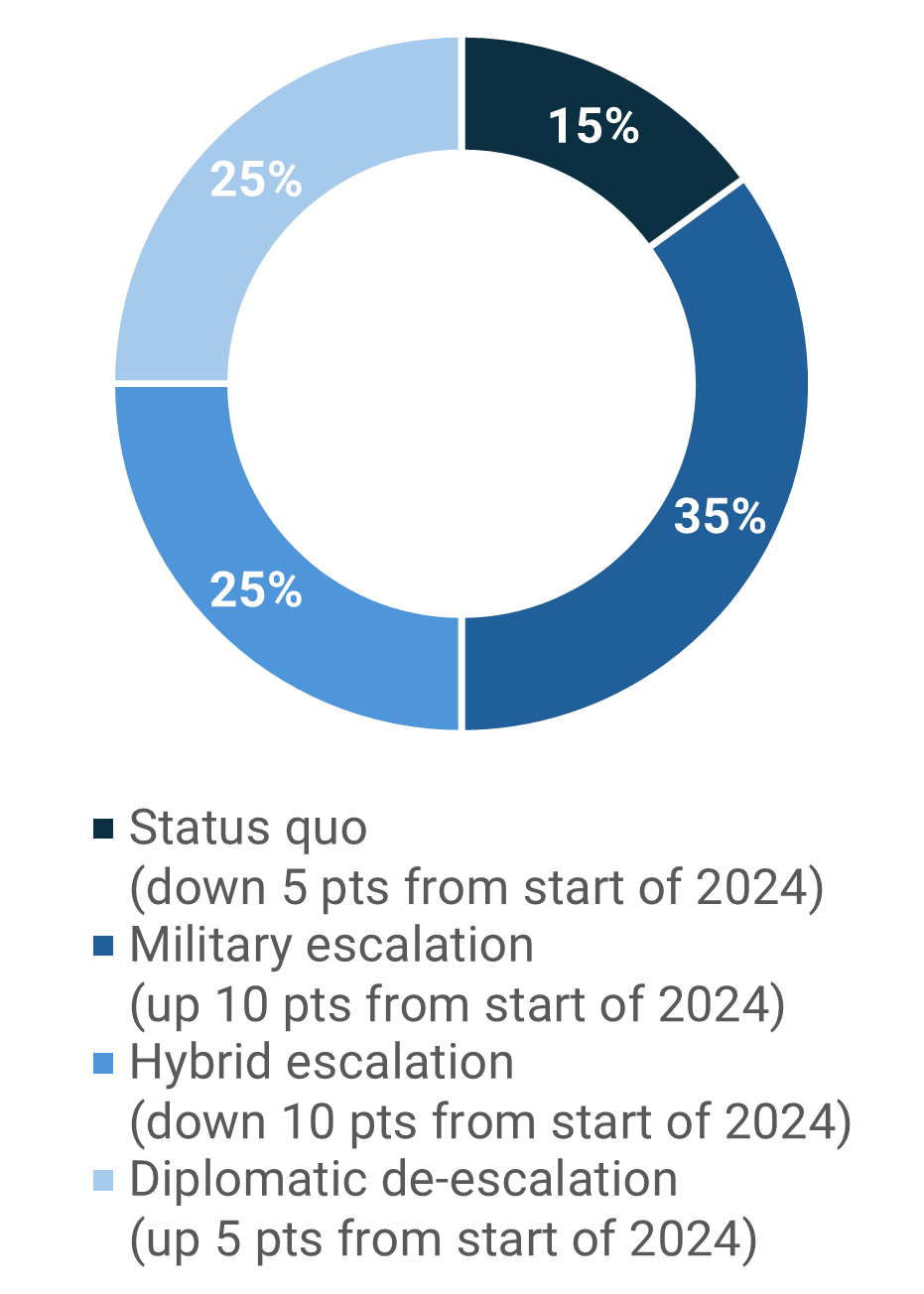
Military escalation scenario
- Israel conducted its first direct airstrike against al-Houthi rebels in Yemen after the group claimed responsibility for a drone attack in Tel Aviv. Israel targeted Yemen’s port city of Hodeidah and intercepted ballistic missiles fired by the Houthis toward the southern Israel city of Eilat. Iran condemned Israel’s attacks, while Hezbollah-affiliated media reported that the Houthis are adding new Israeli sites to their “target bank.”
Risk level – medium - Israel continued its ground and air offensive in Gaza, pushing deeper into Rafah and Khan Younis while issuing a temporary evacuation order in the Al-Mawasi humanitarian zone in Khan Younis.
Risk level – medium - Israel killed five Palestinians during a raid in the West Bank.
Risk level – low/medium
Hybrid escalation scenario
- U.N. Special Envoy to Yemen Hans Grundberg warned that the Houthi threat to shipping in the Red Sea and surrounding waterways is growing following the direct attacks between Israel and the Houthis.
Risk level – medium
Diplomatic de-escalation scenario
- Netanyahu visited the United States to address Congress and meet with President Joe Biden, Vice President Kamala Harris, and former President Donald Trump. Biden vowed to continue to work to end the Israel-Gaza war in his final months in office.
Opportunity level – low/medium - Hamas and Fatah signed a Chinese-mediated declaration to form an “interim national reconciliation government” to govern post-war Gaza at a ceremony in Beijing.
Opportunity level – low
U.S./China/Indo-Pacific
Summary – Tensions in the Indo-Pacific trended toward a military escalation scenario as Taiwan began its annual Han Kuang military exercises and Chinese bombers were intercepted near Alaska for the first time alongside Russian counterparts. The United States sanctioned Chinese companies supplying Belarusian and North Korean military programs. The Philippines and China have reached a preliminary understanding on deconflicting the South China Sea, though tensions remain.
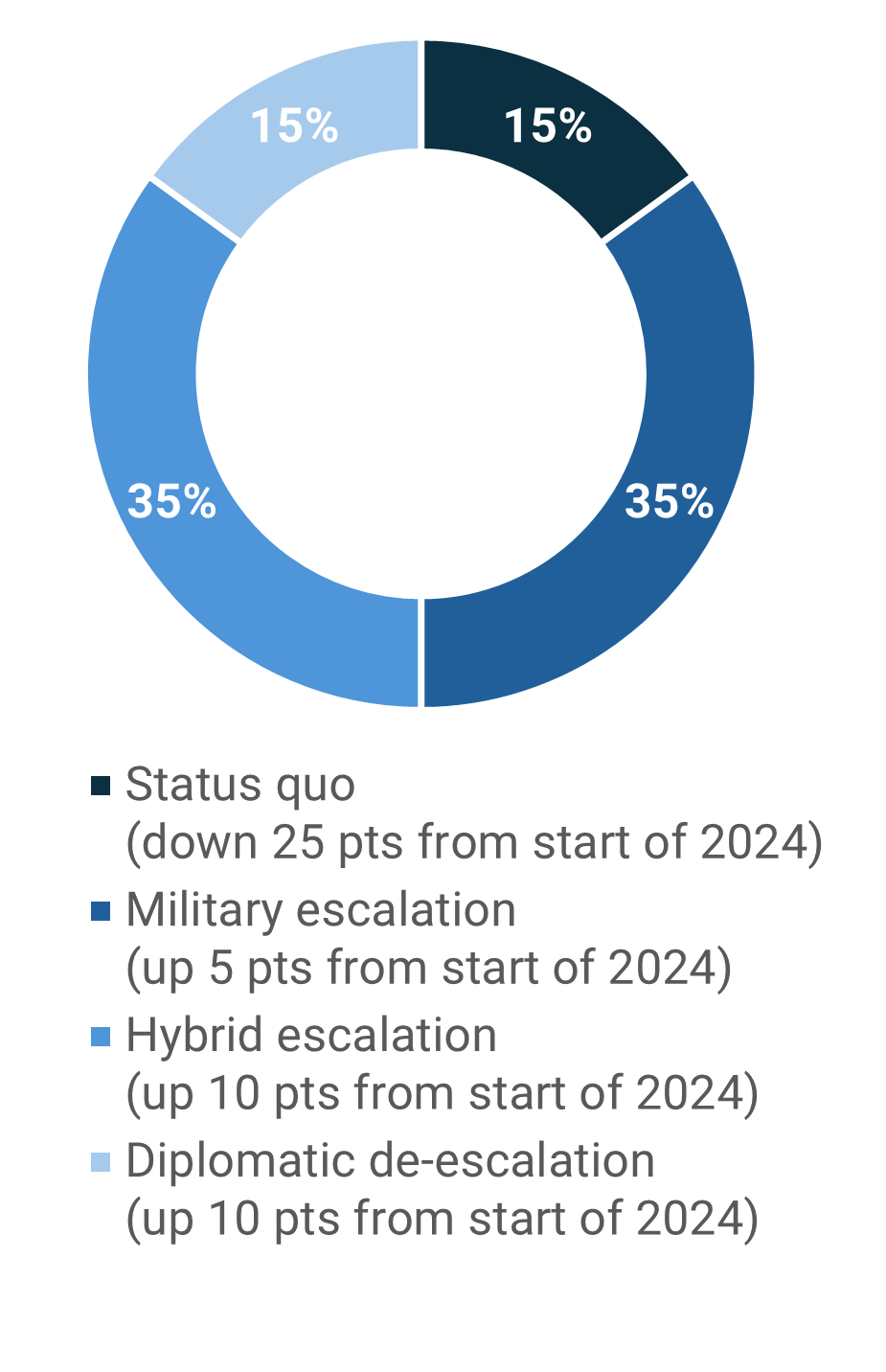
Military escalation scenario
- U.S. and Canadian forces intercepted Chinese and Russian bombers off the coast of Alaska.
Risk level – medium - The Chinese Communist Party announced at the end of its third plenum a pledge to accelerate the development of “strategic deterrence forces,” a term generally associated with nuclear capabilities.
Risk level – medium - Taiwan’s most realistic annual Han Kuang military exercises to date started Monday, aimed at training an effective response to a full-scale invasion by China, including anti-landing drills from troops on the Penghu Islands.
Risk level – low/medium
Hybrid escalation scenario
- North Korea continues to send trash-filled balloons toward South Korea in response to South Korea’s cross-border broadcasts.
Risk level – low/medium - Chinese companies have been supplying the western-sanctioned Belarusian defense contractor BelOMO with precision parts used in laser-guided bombs and missiles.
Risk level – low/medium - The United States announced new sanctions against Chinese individuals and firms accused of supplying North Korea with materials for its ballistic missile program in violation of U.N. Security Council resolutions.
Risk level – low/medium
Diplomatic de-escalation scenario
- The Philippines and China have reached a preliminary understanding on the arrangement for resupply missions to the Sierra Madre, a ship the Philippines stranded on the Second Thomas Shoal in 1999.
Opportunity level – medium - The South Korean and Chinese vice foreign ministers met to discuss enhancing bilateral cooperation and exchanges.
Opportunity level – low/medium
Global Connectivity
The Global Connectivity Tracker examines the sectoral impact of geopolitical dynamics on key themes like the global energy/climate transition, trade, and technology. (Go to the Global Hotspot Tracker)
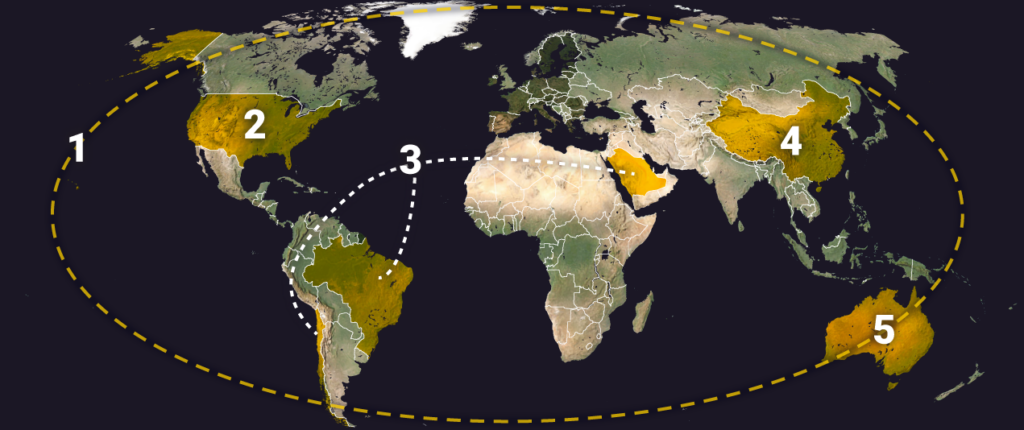
- Global: Electricity
What happened: The International Energy Agency predicts global electricity demand will reach record highs in 2024 and 2025.
Significance/Outlook: Power demand has reached its highest level in two decades due to robust economic growth, rising air conditioning use due to extreme heatwaves, and an increase of electricity-powered technologies like heat pumps and electric vehicles. According to the IEA’s predictions, global electricity demand will climb 4% this year and another 4% in 2025, up from 2.5% last year. Renewable energy sources are growing rapidly and are anticipated to break records, but an accelerated transition to renewable forms of energy is necessary to satisfy climate targets. To reduce power system demand and provide reliable electricity, grids must be upgraded, and energy efficiency targets raised.
Risk level – low/medium - United States: Geothermal Energy
What happened: California startup Fervo Energy is using hydraulic fracturing to develop an enhanced geothermal power plant with the capacity to generate 400 megawatts of electricity.
Significance/Outlook: Geothermal energy power plants use heat of the Earth’s interior to generate steam that drives electricity-generating turbines without releasing heat-trapping greenhouse gases into the atmosphere, but suitable sites for those plants exist in only a few places where water and permeable rock hot enough to create steam naturally exist together. Unlike carbon-free renewable energy sources such as solar and wind, which provide power only when the sun shines or the wind blows, geothermal power plants like Fervo’s, which is slated to come online in 2028, can deliver a constant output of baseload electricity that power grid operators can reliably count on to meet demand. Researchers are also working to develop methods to extract lithium, a key element used in battery manufacture, from the fluid captured from underground by the plants.
Opportunity level – medium - Saudi Arabia/Brazil/Chile: Mining
What happened: Saudi Minister of Industry and Mineral Resources Bandar Alkhorayef visited Brazil and Chile to explore cooperation in the mining industry, with a particular focus on lithium.
Significance/Outlook: As major lithium producers, Brazil and Chile are strategic partners to Saudi Arabia, which seeks to diversify its economy and expand its electric vehicle production. Saudi Arabia owns a 10% stake in Vale Basic Metals, a mining company in Brazil, and is considering a partnership with the state-owned Chilean mining giant Codelco in its Maricunga project to produce lithium. This visit aims to increase the cooperation in this sector and aligns with the goals of the kingdom’s Vision 2030 to transform it into a leading industrial power and a global center for mining and minerals.
Opportunity level – medium - China: Rare Earth Elements
What happened: Major Chinese rare-earth companies are reporting huge financial losses due to declining prices.
Significance/Outlook: Rising Nonferrous Metals in Shanghai has forecasted a net loss ranging from $37.3 million to $42.8 million for the first half of 2024, a stark contrast to the $14.1 million net profit recorded in the same period last year. The company attributed the losses to declining sales prices for rare earth elements like dysprosium, terbium, and didymium. This is a shared struggle with many other companies driven by the continuous decline in rare-earth prices. New government regulations, which enforced state control over rare-earth resources to ensure national and industrial security, may have also contributed to the price drop.
Risk level – low/medium - Australia/Global: Cybersecurity
What happened: Businesses may take days or weeks to recover from last week’s global IT outage caused by Crowdstrike, opening them up to risks posed by malign websites falsely advertising solutions.
Significance/Outlook: Last week, businesses around the world were affected by a faulty software update to CrowdStrike’s Falcon software, which left 8.5 million Windows systems unable to function. While this represents less than 1% of all Windows devices, it was enough to cause major societal and economic disruptions. Flights in the U.S., Australia, and Europe were delayed or cancelled, and many industry workers remain unable to use their computers, which need to be fixed by hand. The Australian Signals Directorate reported an increase in malicious websites offering quick IT fixes for the problem and is warning the public not to use any solutions that are not an official CrowdStrike source.
Risk level – medium
Key Stats of the Week
- Global renewable electricity sources are expected to grow from 30% in 2023 to 35% in 2025
- Renewables are expected to surpass coal in 2025 in global electricity generation.
- Indian electricity demand is predicted to rise 8% this year.
- Demand in China is expected to expand by more than 6% this year.
- U.S. power demand is expected to rise 3% this year.
- Electricity demand in the EU is expected to climb 1.7% this year.
Source: International Energy Agency




